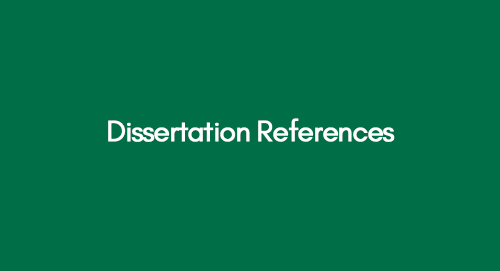Topics form with Ad
February 28, 2023
Dissertation References
February 28, 2023Dissertations differ considerably between particular courses and academic levels, and your instructor or supervisor will provide you with information and direction regarding the style of your dissertation that is relevant to your field of study. It's crucial that you get it properly in your final product.
As you embark on the journey of writing a dissertation, you will likely encounter many challenges and obstacles. With careful planning and execution, you can produce a high-quality dissertation that contributes to your field of study. However, introductions, literature reviews, and conclusions follow a similar format and aim in most fields.
Review Our Quality Dissertation Topics
Dissertation Chapter 1 is the introduction, which sets the stage for your research and provides the reader with a roadmap of what to expect. This blog post will explore the key components of a successful dissertation introduction and some general guidance for organizing your dissertation chapter 1. Following are some dissertation examples to help you get start with writing a dissertation introduction. Review their Introduction sections;
Example: 1 Islam and Christianity Influencing the Gender Role of Women
Example: 2 Impact of Online Banking Intervention on Tradtional Banking
3 Main Elements to Cover in Dissertation Chapter 1
Summaries of your dissertation's what, why and how should be included in introductions. Your dissertation's literature review and methodology will go into further detail about these topics. Here, providing the reader with a precise understanding of your paper's nature and direction is crucial.
i. What
- What is the exact focus, question, or topic being investigated?
- What is the main thesis or hypothesis that is being tested?
- What are the dissertation’s requirements or limitations?
ii. Why
- Justification for the reasons your dissertation is shaped the way it is
- Why it is distinctive, fulfils a research gap, proposes a new question, offers a solution, etc.
iii. How
- A succinct description of the method, theoretical approach, etc.
- The dissertation's prospective layout.
Key Components of a Successful Dissertation Chapter 1
a. Background and Context
The first section of your introduction should offer the reader a better and broad understanding of the context of your research. It includes a discussion of the historical, social, cultural, or theoretical background that informs your work. You should also articulate the research problem you are addressing and explain why it is important to your field of study.
b. Purpose and Research Questions
The next section of your dissertation, chapter 1, clearly describes the purpose of your research and the research questions you seek to answer. This section should be concise and focused, as it sets the stage for the remainder of your dissertation.
Go through this guide to better understand how to propose research questions for your dissertation.
Expert Tips on How to Write a Research Question with Real Examples
c. Significance and Contribution
In this section, describe the importance of your research and the contribution it provides to your field of study. It could cover a description of your research's real-world uses or its theoretical ramifications. Identifying the gaps in prior research that your work aims to address can help you place your research within the larger context of your field.
d. Methodology and Approach
Finally, you should provide an overview of the methodology and approach used to conduct your research. An explanation of the methods you used for data collection, data analysis, and research design can be covered. A concise synopsis of your dissertation's structure should also be included, along with a description of the chapters after the introduction.
Tips to Start Your Introduction Effectively
Here’s a step-by-step guide to help you write an effective and engaging dissertation Chapter 1 that will draw in readers and get them excited about what’s to come.
Step #1: Understand Your Topic
Before diving into your dissertation Chapter 1, it’s important that you understand the topic on which you are writing. Take some time to look at previous dissertations on similar topics and familiarize yourself with their structure and content.
It will provide you with a better understanding of how to approach your paper. Additionally, ensure that you have conducted thorough research on your chosen topic—this is essential for writing an effective Chapter 1, as it will provide valuable context for the rest of your dissertation.
If you need assistance in creating an eye-catching and engaging title for your dissertation, here is a way to complete the guide:
Step #2: Create an Outline
Creating an outline before you begin writing can be extremely helpful in keeping your thoughts organized and ensuring that each point flows logically from one to the next.
Start by developing a broad overview of what you want to cover in each section, then break those sections down into smaller subsections with more specific points.
Once you have created this outline, use it as a roadmap when you start drafting your paper so that nothing important gets left out or forgotten along the way.
Step #3: Get Your Point Across Clearly
When crafting Chapter 1 of your dissertation, remember that clarity is key! Make sure all your points are clear and easy to understand without getting too bogged down in unnecessary details or jargon.
You should also aim for conciseness—cut out any information or sentences that don't add anything meaningful or relevant to your paper and stick only with what is necessary to understand the topic.
It will help ensure that readers stay engaged throughout Chapter 1 and remain interested enough in what they read to continue with Chapters 2 through 5 (or however many chapters are included).
Conclusion
Writing a dissertation chapter 1 can seem intimidating at first, but breaking it down into smaller pieces becomes more manageable. By focusing on providing an overview of what will be discussed in later chapters as well as providing background information on why these subject matters and how it relates to existing knowledge in this field, you can create an effective introduction for your dissertation project that will set up readers for success throughout the rest of their reading experience
Get 3+ Free Custom Topics within 24 hours;
Get an Immediate Response
Discuss your custom requirements with our writers
Free Online Plagiarism Checker For Students
We will email you the report within 24 hours.
Upload your file for free plagiarism





























